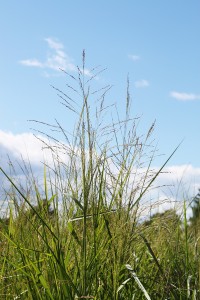Grass for Heating Fuel in Vermont
By Sarah Galbraith
Grass biomass could make a sizeable contribution to Vermont’s heating needs over time, and could be part of the renewable energy mix required to meet the state’s goal to meet 90% of Vermont’s energy needs through renewable energy and increased efficiency by 2050.
A new report released by the Vermont Sustainable Jobs Fund evaluates grass biomass energy as a potential heating fuel. Grass Energy in Vermont and the Northeast summarizes current research on the agronomy and usage potential of grass as a biofuel, and points to next steps for the region to fully commercialize this opportunity.

Switchgrass planted for fuel at Meach Cove Farm in Shelburne, Vermont.
Credit: Vermont Bioenergy Initiative
One important recommendation in the report was that an investment in grass pellets for the consumer market is not the right investment for Vermont. This is because grass pellets are lower quality than wood pellets, meaning they do not make good fuel for home heating stoves. While some boilers can accommodate grass, this fuel tends to make better sense for small-scale commercial and institutional markets.
While grass pellets for the consumer market are not ideal for Vermont, there are other models that do make sense. Regional and closed-loop processing were two models recommended, both involving farmers growing and harvesting grass, but differing in where the grass is processed into fuel and where it is used. The regional processing model calls for aggregating grass from a 50-mile radius at a central processing facility, where the grass is made into and used as fuel, or sold to local users. The closed-loop model suggests farmers growing and processing grass on-site for farm or community use.
Perennial grasses can be grown on marginal lands not well suited for continuous row crop production and in open rural land currently not in agricultural production. Recommendations of the report include a concerted effort in Vermont to plant grasses for energy on extended buffer strips along Lake Champlain, thereby reducing its nutrient load.
More information on grass for energy, and a full copy of the report, can be found on the Vermont Bioenergy Initiative website at vermontbioenergy.com/grass.
The Vermont Bioenergy Initiative is a program of the Vermont Sustainable Jobs Fund and partners with other organizations expanding the use of renewable energy in Vermont like Renewable Energy Vermont and the Energy Action Network. The Vermont Bioenergy Initiative also coordinates crossover with the Vermont Farm to Plate Network by providing resources and technical assistance to farmers, facilities, and communities to support energy crops to be grown alongside food production. VermontBioenergy.com.
Sarah Galbraith is program manager of the Vermont Bioenergy Initiative.








Leave a Reply